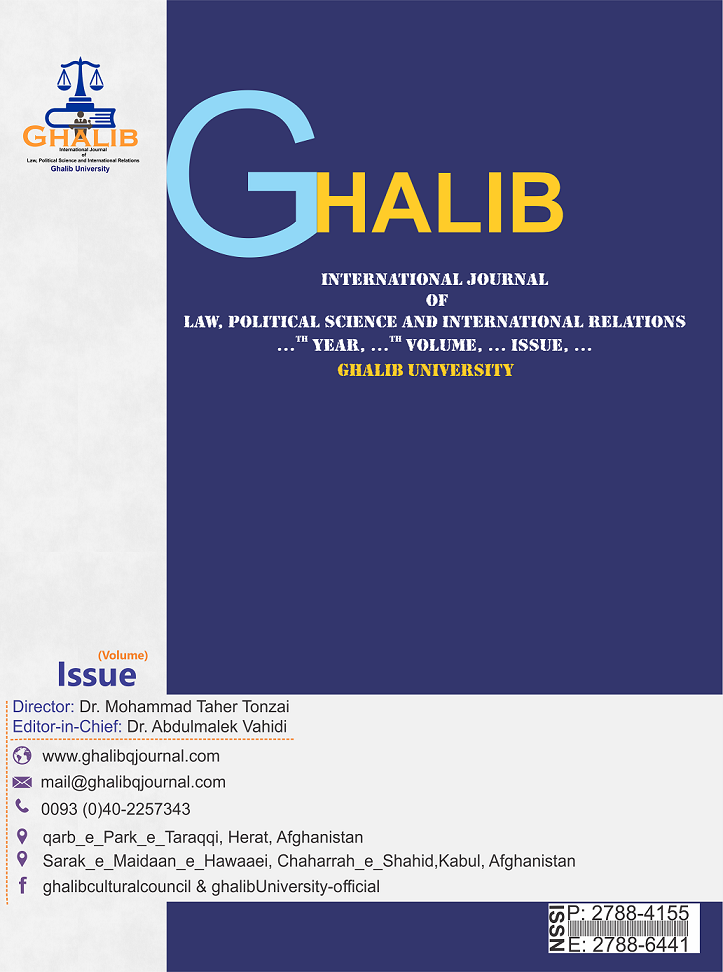Death familiarity and eternal life in Poetical works of Sohrab Sepehri and Alexander Sergeyevich Pushkin
DOI:
https://doi.org/10.58342/ghalibqj.V.12.I.3.3Keywords:
Sepehri, Pushkin, death, eternal life, mysticaAbstract
Death and eternal life are amongst the most important issues that humans have faced throughout history and still try to find a correct answer to the whyness of creation and its philosophy. Each of the Philosophers and mystical poets viewed this topic from a specific aspect. Alexander Sergeyevich Pushkin, the father of Russian poetry, has also a diverse and different point of view toward death. He has addressed this issue from different points of view. Sohrab Sepehri contemporary poet of Iran (1307-1359) also has taught about death and life in some of his poems. This topic mutuality has been the subject of present research in order to the two poets different thoughts be analyzed. Regarding to the specific worldview of each poets their attitude toward these two topics are different comparing to each other.Therefore, the main objective of this paper is to find an answer to the question that how death familiarity and eternal life has been explained in Pushkin’s and Sepehri’s Poetical works and to analyze it by using a descriptive and analytical method. Both Sepehri and Pushkin issue death as much as other fundamental human issues and they keep a positive and steady attitude toward death and accept it as a reality of life.
References
۱. قرآن کریم. (1372). ترجمۀ ناصر مکارم شیرازی. سورۀ عنکبوت، آیۀ 64. قم: انتشارات دارالقرآن الکریم. 404.
۲. آذرنیوار، لیلا؛ پورالخاص، شکرالله؛ کیانی، احمدرضا. (۱۴۰۱). «بررسی مرگ و تأثیر آن بر زندهگی در آثار سعدی با تکیه بر رواندرمانگری اگزیستانسیال اروین یالوم». ایران: دوفصلنامۀ علمی زبان و ادبیات فارسی دانشگاه خوارزمی. ۳۰ (۹۲). صص ۷-۳۰. URL: http://jpll.khu.ac.ir/article-1-4180-fa.html.
۳. آلبوم، میچ. (1385). سه شنبهها با موری. ترجمۀ ماندانا قهرمانلو. چ دوم. تهران: انتشارات قطره.
۴. برزگر، محمدرضا. (1371). مفاتيحالاعجاز في شرح گلشن راز. تهران: انتشارات زوار.
۵. پوشکین، الکساندر سرگییویچ. (1384). سوارکار مفرغی. ترجمة حمیدرضا آتش برآب. تهران: انتشارات هرمس.
۶. ترویا، هانری. (1374). پوشکین (زندهگینامه). ترجمۀ حسینعلی هروی. تهران: انتشارات البرز.
۷. تیلیش، پل. (1384). شجاعت بودن. ترجمۀ مراد فرهادپور. چ سوم. تهران: انتشارات علمی و فرهنگی.
۸. رحیمیان، سعید؛ جباره ناصرو، محبوبه. (1389). «ترس از مرگ در آثار عطار». ایران: مجلۀ ادبیات عرفانی. شـمــارة 3. صص 38 تا 55. http://www.noormags.com/view/fa/articlepage/844133.
۹. زماني، كريم. (1386). ميناگر عشق. چ ششم. تهران: نشر ني.
۱۰. زنديپژوه، ناهيد. (03/04/1388). «پوشكين و تأسي از قرآن». ایران: روزنامۀ كيهان. شماره 19394. برداشت: 10/11/1401.
۱۱. سپهری، سهراب. (1378). هشت کتاب. چ چهارم. تهران: انتشارات طهوری.
۱۲. سقازاده، بهاره؛ مطلق، بهمن نامور. (1400). «گذار از وحشت مرگ بهعنوان دیگری به واسطۀ زبان زنانه؛ خوانشی از بالکن اثر ژنه». ایران: مجلۀ نقد زبان و ادبیات خارجی. دوره هجدهم. شـمــارۀ 27. صص ۲۶۵-۲۹۱.. https://doi.org/10.52547/clls.18.27.265
۱۳. شبستری، محمود. (تألیف 717 ه.ق.). گلشن راز. تصحیح و مقابله امیر حسین خنجی. نسخۀ الکترونیکی، نشر الکترونیک: وبگاه "ایران تاریخ"، تاریخ انتشار 29 مهر 1388. http://ketaab.iec-md.org/e-adabi/pdf/golshaneraaz.pdf.
۱۴. شهاب، بابک. (1378). برگزیده اشعار پوشکین "برایم ترانه بخوان!". تهران: انتشارات لاهیتا. نسخۀ الکترونیکی: http://blog.ahmadnia.net/spip.php?article1402.
۱۵. شمیسا، سیروس. (1378). نگاهی به سهراب سپهری. چ چهارم، تهران: انتشارات مروارید.
۱۶. عماد، حجت. (1377). سهراب سپهری و بودا. تهران: انتشارات فرهنگستان یادواره.
۱۷. فروغی، حسن؛ رضایی، مهناز. (1392). «تصویر مرگ و زندهگی در شعر معاصر ایران». ایران: مجلۀ پژوهش ادبیات معاصر جهان. دورۀ 18. شمارۀ 2. https://jor.ut.ac.ir/article_52047.html.
۱۸. کازنتزاکیس، نیکوس. (1387). گزارش به خاک یونان. ترجمۀ صالح حسینی. چ پنجم، تهران: انتشارات نیلوفر.
۱۹. کریمی مطهر، جانالله؛ یحییپور، مرضیه. (1390). الکساندر پوشکین و مشرق زمین. تهران: انتشارات پژوهشگاه علوم انسانی و مطالعات فرهنگی.
۲۰. مولوی، جلالالدین محمد. (1372). مثنوی معنوی. بهکوشش: محمد استعلامی. ج 3. چ سوم. تهران: انتشارات زوار.
۲۱. نفیسی، سعید. (1367). تاریخ ادبیات روسیه. چ دوم، تهران: انتشارات توس.
۲۲. ﻧﻮروزی، داوودﺧﺎﻧﻲ؛ ﺛﻮراﷲ، ﺣﺴـﻴﻨﻌﻠﻲ ﻗﺒﺎدي. (1379). «ﺑﺮرﺳﻲ و ﺗﺤﻠﻴـﻞ ﻣﻀـﺎﻣﻴﻦ ﻣـﺮگ در ﺷـﻌﺮ ﻣﻮﻟﻮی، ﺧﻴـﺎم، ﺳﻬﺮاب ﺳﭙﻬﺮي و ﻓﺮﻳﺪون ﺗﻮﻟلی». ﭘﺎﻳﺎننامۀ ﻛﺎرﺷﻨﺎﺳﻲ ارشد رشتۀ زﺑﺎن و ادﺑﻴﺎت ﻓﺎرﺳﻲ. بهرهنمایی: دکتر حسینعلی قبادی. دانشکدۀ ﻋﻠﻮم اﻧﺴﺎنی. دانشگاه ﺗﺮﺑﻴﺖ ﻣـﺪرس. ﺗﻬـﺮان.
۲۳. نیچه، فریدریش. (1384). چنين گفت زرتشت. ترجمۀ داريوش آشوری. تهران: انتشارات آگاه.
۲۴. یالوم، اروین. (1387). مامان و معنای زندهگی. ترجمۀ سپیده حبیب. تهران: انتشارات کاروان.
۲۵. یزدانپناه، مهرعلی؛ جویباری، احمد هاشمی. (03/ تیر 1390). «مرگ و حیات در حدیقۀ سنایی». ایران: روزنامۀ اطلاعات. برداشت: 10/11/1401.
Камалетдинова, А. Я. (2019). Мировоззренческие подходы к феномену здоровья в различных культурах / А. Я. Камалетдинова, А. Б. Невелев // Вестник Челябинского государственного университета. Образование и здравоохранение. 3–4 (7–8):5–8.
Лосев А.В. (2020). Трагедия смерти и драма жизни/ А.В. Лосев // КОМОТНБТ1КЛ: Философия. Социология. Право. 45 (3): 460-467. DOI 10.18413/2712-746X-2020-44-3 -460-467
Пушкин, А. С. (1958). Полное собрание сочинений: В 10 т. –М.: АН СССР. Т.3.–284 с. https://rvb.ru/pushkin/tocvol3.htm
Пушкин, А. С. (1974). В воспоминаниях современников. В двух томах. –М.: Художественная литература. Т.1.–541с. http://www.bibliofond.ru/view.aspx?id=600476
References
Translation of the Holy Quran. (1994). Naser Makarem Shirazi, Surah Al-Ankabut, Ayat 64. Qom: Dar al-qoran. Al-karim Publications. 404 p. (in Persian).
Albom, Mitch (2006). Tuesdays with Morrie. Translated by Mandana Ghahremanloo second edition, Tehran: Qatre Publications. (in Persian).
Azarnivar, L.; Pour-Alkhas S.; Kiani A R. (2022). A Study of Death and Its Effect on Life in Saadi’s Works Based on Irvin Yalom’s Existential Psychotherapy. Biannual scientific journal of Persian language and literature of Khwarazmi University (JPLL); 30 (92). 7-30.URL: http://jpll.khu.ac.ir/article-1-4180-fa.html. (in Persian).
Barzegar, Mohammad Reza (1992). Keys of miracles in explaining Gulchen Raz. Tehran: Zavvar Publications. (in Persian).
Emad, Hojjat (1998), Sohrab Sepehri and Buddha, Tehran: Farhangistan Yadvareh. Publications (in Persian).
Foroughi, Hassan; Rezaei, Mahnaz (2013). Images of Death and Life in Contemporary Iranian Poetry, journal of Research in Contemporary World Literature (RCWL). 18 (2). (https://jor.ut.ac.ir/article_52047.html). (in Persian).
Karimi Motahhar, Janolah, Yahyapour, Marzieh (2011), Alexander Pushkin and the Orient. first edition, Tehran: Research Institute for Humanities and Cultural Studies Publications. (in Persian).
Kamaletdinova A.Ya., Nevelev A.B. (2019). Worldview approaches to the phenomenon of health in various cultures. Bulletin of Chelyabinsk State University. Education and Healthcare, 3-4 (7-8):5-8. (in Russian).
Kazantzakis, Nikos (2008), Report to Greco. Translated by Saleh Hosseini, fifth edition, Tehran: Nilofer Publications (in Persian).
Losev A.V. (2020). The tragedy of death and the drama of life. KOMOTNBT1KL: Philosophy. Sociology. Right. 45(3): 460-467. DOI 10.18413/2712-746X-2020-44-3-460-467(in Russian).
Molavi, Jalaluddin Mohammad (1993), Masnavi i Ma'navi. Mohammad Estelami, volume 3, third edition, Tehran: Zovar Publications (in Persian).
Nafisi, Saeed (1988), History of Russian Literature, second edition, Tehran: Tus Publications (in Persian).
Nietzsche, Friedrich. (2005). Thus Spoke Zarathustra. Translated by Daryoush Ashouri, Tehran: Aghah Publications.
Norouzi, Davoud Khani; Sourallah, Hossein Ali Ghobadi. (2000). Examining and analyzing the themes of death in the poetry of Molloy, Khayyam, Sohrab Sepehri and Fereidoon Tavallali. Master's Thesis, Department of Persian Language and Literature, Faculty of Humanities of Tarbiat Modares University, Tehran. (in Persian).
Pushkin, A.S. (1958). Complete works in ten volumes. Moscow: AN SSSR.. 3rdVolume. 284p. https://rvb.ru/pushkin/tocvol3.htm (in Russian).
Pushkin, A.S. (1974). In the memoirs of contemporaries. - Moscow: Fiction, - T. 1. -541 p. URL: http://www.bibliofond.ru/view.aspx?id=600476 (in Russian).
Pushkin, A.S. (2005). Bronze Horseman. Translated by Hamidreza Atash Barab. First edition, Tehran: Hermes Publications. (in Persian).
Rahimian, Saeed; Jabare Nasero, Mahbube (2010). Fear of death in Attar's works. Journal of Mystical Literature. (3). 38 -55. https://www.noormags.ir/view/fa/articlepage/844133. (in Persian).
Saghazade Bahare, Motlagh Bahman Namvar (2022). Bypassing the Horror of The Death by the Use of Feminine Writing: A Study of Jean Genet’s The Balcony. Journal of Critical Language & Literary Studies 18(27), 265-291.
Sepehri, Sohrab (1999). Eight books, fourth edition, Tehran: Tahuri. (in Persian).
Shabestari, Mahmoud (1311). Gulshan-i Rāz, Amir Hassan Khanji. https://ganjoor.net/shabestari/golshaneraz/sh45/(in Persian).
Shahab, Babak (1999), A selection of Pushkin's poems "Sing me a song!", Tehran: Lahita Publications (http://blog.ahmadnia.net/spip.php?article1402) (in Persian).
Shamisa, Siros (1999). Take a look at Sohrab Sepehri, 4th edition, Tehran, Morvarid Publications (in Persian).
Tillich, Paul (2005). The Courage to Be. Murad Farhadpour, third edition, Tehran: Scientific and Cultural Publications. (in Persian).
Troyat, Henri (1995). Pushkin: A Biography. Translated by Hossein Ali Heravi, first edition, Tehran: Alborz Publications (in Persian).
Yalom, Irvin D. (2008).Momma and the Meaning of Life. Translated by Sepideh Habib, first edition, Tehran: Karvan Publications (in Persian).
Yazdanpanah, MehrAli; Joybari, Hashemi Ahmad (2011). Death and life in "Hadiqat" Sanai. Ettelaat newspaper. Friday, July 03. (in Persian).
Zamani, Karim (2007). The minaret of love. 6h edition, Tehran: Nashr-e Ney Publications (in Persian).
Zandi Pajooh, Nahid (2009). Pushkin and obedience to the Qur'an. Keyhan Newspaper. No. 19394, dated 3/4/88. (in Persian).
Downloads
Published
How to Cite
Issue
Section
License
Copyright (c) 2023 ghalib quarterly journal

This work is licensed under a Creative Commons Attribution 4.0 International License.













